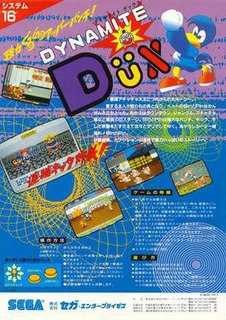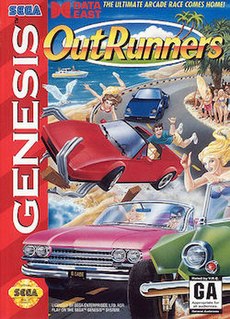 W
WAfter Burner is a 1987 combat flight simulator arcade game developed and published by Sega. The player assumes control of an American F-14 Tomcat fighter jet, and must clear each of the game's eighteen unique stages by destroying incoming enemies, using both a machine gun and a limited supply of heat-seeking missiles. It uses a third-person perspective, previously utilized by Sega's earlier games Out Run and Space Harrier, and runs on the Sega X arcade system.
 W
WAfter Burner Climax is a combat flight video game developed and published by Sega. The game is a part of the After Burner series, and was first released in arcades in 2006 and was later ported to Xbox Live Arcade and PlayStation Network in April 2010.
 W
WAfter Burner II is an arcade-style flight game released by Sega in October 1987. It is the second game in the After Burner series. In the game, players fly an F-14 Tomcat jet fighter, gunning down enemies while avoiding incoming fire. After Burner II came both a standard arcade cabinet and a servo actuated, sit-down version which moved according to the motion of the plane onscreen. The cockpit would bank in the same direction the on-screen aircraft was banking.
 W
WAlex Kidd: The Lost Stars is a platform arcade game released by Sega in 1986. It was ported to the Master System in 1987. It was also released on the Wii Virtual Console in North America on March 9, 2009, and in the PAL regions on April 17, 2009.
 W
WDerby Owners Club (DOC) is a horse racing simulation arcade game made by Sega-AM3. The format of the game is a player uses one of several consoles at the arcade to train horses, and then races them against 11 other computer AI horses or any number of other players on tracks and G-1 races.
 W
WDynamite Düx is a side-scrolling 'beat 'em up' video game created by Sega AM2 and released by Sega in December in arcades in 1988. It uses the Sega System 16 arcade board, the same board used for Golden Axe and Altered Beast. It was ported to the Amiga, Amstrad CPC, Atari ST, Commodore 64, Master System, and ZX Spectrum in the following year.
 W
WEnduro Racer (エンデューロレーサー) is an arcade game from Sega. It was released in 1986 with either a stand up cabinet with handlebars or a full-sized dirt bike on the cabinet itself. Many people see it as essentially the dirt version of Hang-On, as it uses a similar engine and PCB.
 W
WFantasy Zone is a 1986 arcade game by Sega, and the first game in the Fantasy Zone series. It was later ported to a wide variety of consoles, including the Master System. The player controls a sentient spaceship named Opa-Opa who fights an enemy invasion in the titular group of planets. The game contains a number of features atypical of the traditional scrolling shooter. The main character, Opa-Opa, is sometimes referred to as Sega's first mascot character.
 W
WG-LOC: Air Battle is a 1990 combat flight simulator arcade game developed and published by Sega. It is a spin-off of the company's After Burner series. The title refers to "G-force induced Loss Of Consciousness".
 W
WGhost House is a side-scrolling horror-action video game developed and published by Sega, released for the Master System in 1986. Ghost House is loosely based on Sega's 1982 arcade game, Monster Bash.
 W
WGP Rider is a motorcycle racing arcade game developed and manufactured by Sega released in 1990 in Japan, North America, and Europe. It was also ported to the Sega Master System and Game Gear in 1993.
 W
WHang-On is an arcade game released by Sega in 1985 and later ported to the Master System. In the game, the player controls a motorcycle against time and other computer-controlled bikes. It was one of the first arcade games to use 16-bit graphics and utilizes the Super Scaler arcade system board, created with design input from Suzuki, as technology to simulate 3D effects. The deluxe cabinet version also introduced a motion controlled arcade cabinet, where the player's body movement on a large motorbike-shaped cabinet corresponds with the player character's movements on screen.
 W
WHot Rod is a top-down arcade racing game developed by Sega. Released for arcades in 1988 in Japan and in 1989 worldwide, the game was available in a four-player cocktail-style cabinet as well as a three-player upright cabinet. Home computer ports were published by Activision in 1990 for the Amiga, ZX Spectrum, Amstrad CPC, Commodore 64, and Atari ST.
 W
WMaimai is an arcade rhythm game developed and distributed by Sega, in which the player interacts with objects on a touchscreen and executes dance-like movements. The game supports both single-player and multiplayer gameplay with up to 4 players.
 W
WOut Run is a racing video game released in arcades by Sega in September 1986. It is known for its pioneering hardware and graphics, nonlinear gameplay, and a selectable soundtrack with music composed by Hiroshi Kawaguchi. The goal is to avoid traffic and reach one of five destinations.
 W
WOutRun 2 (アウトラン2), usually stylized as OutRun2, is a 2003 racing game released by Sega for the arcades.
 W
WOutRun 2006: Coast 2 Coast is a racing game developed by Sumo Digital and published in 2006 by Sega AM2. It is the 9th title in the series. Outrun 2006 is a re-imagining of the Out Run, the first game in the series and has a new game engine and modern graphics. The game is split into two parts: a conversion of OutRun 2 SP and "Coast 2 Coast", which includes single-player races and challenges, and local network and internet multiplayer.
 W
WOutRunners (アウトランナーズ) is a racing video game developed by Sega and AM1 and released in Japan, Europe, and North America in 1992. It constitutes the third release in the arcade OutRun series and was ported to the Mega Drive in 1994.
 W
WPower Drift is a kart racing game released in arcades by Sega in 1988. Like Sega's earlier racing games Hang-On (1985) and Out Run (1986), Power Drift makes pervasive use of sprite scaling to give a 3D feel. The upgraded hardware of the Sega Y board also allows individual sprites and the background to be rotated–even while being scaled–making the visuals more dynamic.
 W
WRent A Hero is an action role-playing video game series released by Sega for the Mega Drive console in 1991 with a large emphasis on humor. The game features the same graphic engine previously used in the development of Sword of Vermilion. However, Rent A Hero has an unusual innovation for the genre. Instead of using standard turn-based battles, fights are in a similar format to 2D fighting games.
 W
WSega Rally 2006 is an arcade oriented racing game developed and published by Sega for PlayStation 2. It is the third installment in the decade running Sega Rally series, and it was released in Japan on January 12, 2006. This version is the first non-arcade-version–based Sega Rally. Its action footage was used in World Rally Championship.
 W
WSega Touring Car Championship is an arcade racing game released by Sega's AM Annex for the Model 2 mainboard in 1996. It was later ported to the Sega Saturn.
 W
WSegaSonic the Hedgehog is a 1993 arcade game in the Sonic the Hedgehog series by Sega. Controlling Sonic the Hedgehog and his friends Mighty the Armadillo and Ray the Flying Squirrel, the player must escape an island as quickly as possible after they are kidnapped by series antagonist Doctor Eggman. The game is presented from an isometric perspective and players use a trackball to move the characters while dodging obstacles and collecting rings. The game was developed by Sega's arcade division, Sega AM3; it is one of four Sonic games to bear the SegaSonic name and was inspired by the 1984 game Marble Madness.
 W
WSpace Harrier is a third-person rail shooter developed by Sega Enterprises and released in December 1985. Originally conceived as a realistic military-themed game played in the third-person perspective and featuring a player-controlled fighter jet, technical and memory restrictions resulted in Sega developer Yu Suzuki redesigning it around a jet-propelled human character in a fantasy setting. With an analog flight stick and a cockpit-style cabinet that tilted and rolled during play, it was advertised by Sega as a taikan arcade game.
 W
WSword of Vermilion is an action role-playing game developed and published by Sega for the Mega Drive console in 1989. It was released in 1991 in North America and Europe. It was the first console exclusive game designed by the Sega AM2 studio. The game is part of the Sega Genesis Collection for the PlayStation 2 and PlayStation Portable, and was available on the Wii's Virtual Console.
 W
WTurbo OutRun (ターボアウトラン) is a 1989 arcade racing game released by Sega. A follow-up to 1986's Out Run, it was released as a dedicated game, as well as an upgrade kit for the original Out Run board.
 W
WWaveRunner is a trademarked name and type of personal water craft (PWC) produced by the Yamaha Motor Company. Unique to the WaveRunner among PWCs is the spout of water that shoots into the air from the rear of the vehicle, a visual brand identifier that exists as a trademark of Yamaha.